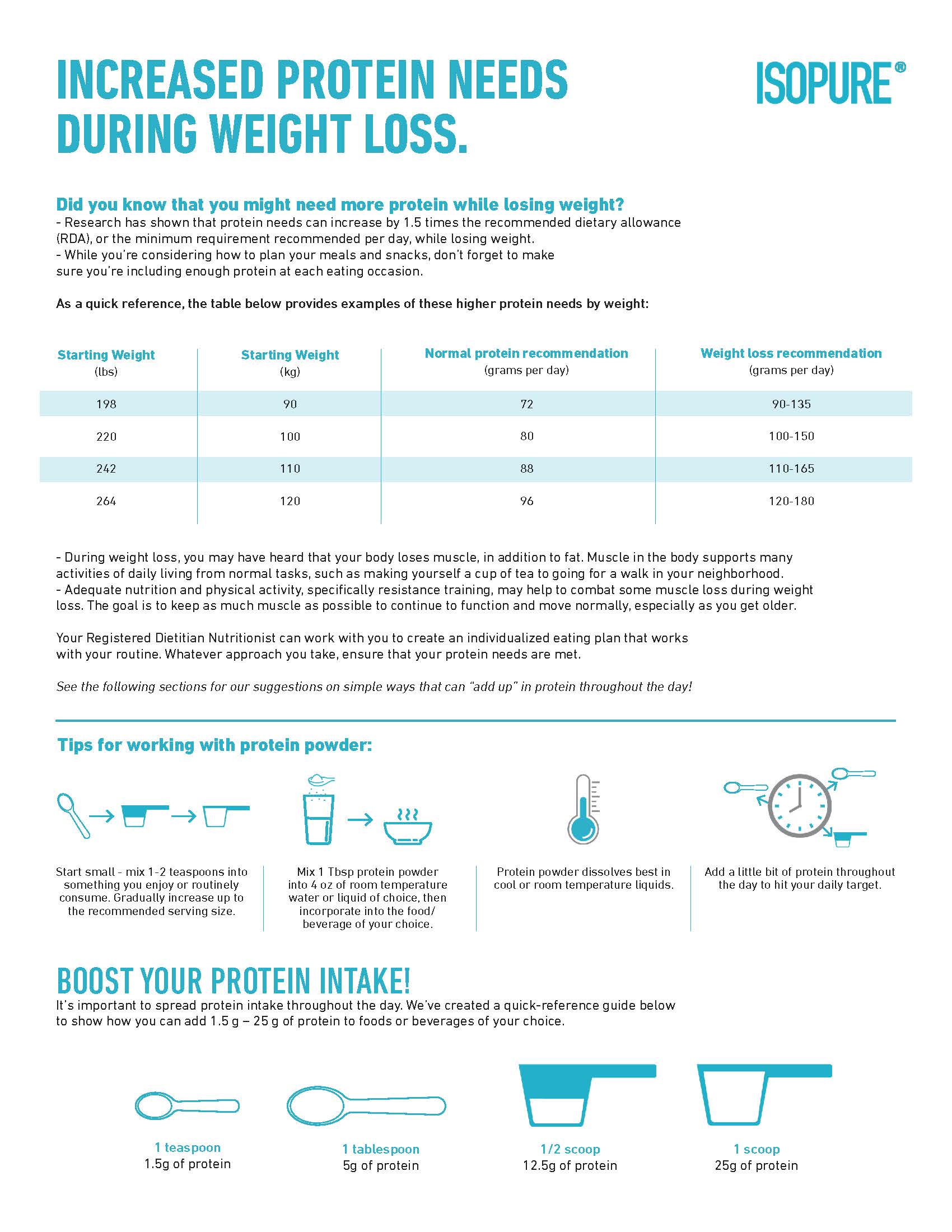
Did you know that you might need more protein while losing weight?
- Research has shown that protein needs can increase by 1.5 times the recommended dietary allowance (RDA), or the minimum requirement recommended per day, while losing weight.
- While you’re considering how to plan your meals and snacks, don’t forget to make sure you’re including enough protein at each eating occasion.
As a quick reference, the table below provides examples of these higher protein needs by weight:
| Starting Weight (lbs) | Starting Weight (kg) | Normal protein recommendation (grams per day) | Weight loss recommendation (grams per day) |
|---|---|---|---|
| 198 | 90 | 72 | 90-135 |
| 220 | 100 | 80 | 100-150 |
| 242 | 110 | 88 | 110-165 |
| 264 | 120 | 96 | 120-180 |
| Starting Weight (lbs) | Starting Weight (kg) |
|---|---|
| 198 | 90 |
| 220 | 100 |
| 242 | 110 |
| 264 | 120 |
| Normal protein recommendation (grams per day) | Weight loss recommendation (grams per day) |
|---|---|
| 72 | 90-135 |
| 80 | 100-150 |
| 88 | 110-165 |
| 96 | 120-180 |
- During weight loss, you may have heard that your body loses muscle, in addition to fat. Muscle in the body supports many activities of daily living from normal tasks, such as making yourself a cup of tea to going for a walk in your neighborhood.
- Adequate nutrition and physical activity, specifically resistance training, may help to combat some muscle loss during weight loss. The goal is to keep as much muscle as possible to continue to function and move normally, especially as you get older.
Your Registered Dietitian Nutritionist can work with you to create an individualized eating plan that works with your routine. Whatever approach you take, ensure that your protein needs are met.
See the following sections for our suggestions on simple ways that can “add up” in protein throughout the day!
Tips for working with protein powder:

Start small - mix 1-2 teaspoons into something you enjoy or routinely consume. Gradually increase up to the recommended serving size.

Mix 1 Tbsp protein powder into 4 oz of room temperature water or liquid of choice, then incorporate into the food/ beverage of your choice.

Protein powder dissolves best in cool or room temperature liquids.

Add a little bit of protein throughout the day to hit your daily target.
Boost your protein intake!
It’s important to spread protein intake throughout the day. We’ve created a quick-reference guide below to show how you can add 1.5 g – 25 g of protein to foods or beverages of your choice.

1 teaspoon
1.5g of protein

1 tablespoon
5g of protein

1/2 scoop
12.5g of protein

1 scoop
25g of protein
Savory foods:
| Amount of Food/Beverage | Mixing Instructions | Amount of Additional Protein |
|---|---|---|
| 1 cup sauce | Mix 2 Tbsp protein powder into 1 Tbsp water. Add to sauce. | 10g |
| Cream-based soup | Mix ½ scoop protein powder into 2 Tbsp water. Add to soup. | 12.5g |
| Broth-based soup | Mix ½ scoop protein powder into 2 Tbsp water. Add protein mixture before adding noodles or other chunky ingredients. | 12.5g |
| 1 cup cream-based salad dressing *Note: not recommended to add to oil-based salad dressings | Mix ½ scoop protein powder into dressing. | 12.5g |
| 1 cup mashed potatoes, sweet potatoes, or cauliflower *Note: for cauliflower, be sure to boil and then puree the cauliflower prior to adding protein powder | Mix 1 tbsp protein power into 1 tbsp milk or water. Add to the mashed potatoes. | 5g |
| Roasted, cubed potatoes or sweet potatoes | Before baking on a sheet pan, add 1 tbsp of protein powder to the seasoning mix of your choice. Toss the cubed potatoes in the seasoning blend and coat evenly. Evenly distribute the potatoes on a sheet pan for roasting. | 5g |
| Cauliflower rice | Mix 1 tbsp protein powder per 1 cup cauliflower rice. Mix in well. | 5g |
| 1 cup mashed butternut squash | Mix 2 tbsp protein powder into mashed butternut squash. | 10g |
| Roasted butternut squash | Add 1 tbsp protein powder into seasoning mix. Coat cubed butternut squash with seasoning mix and evenly distribute the squash on a sheet pan for roasting. | 5g |
| 1 cup hummus | Mix ½ scoop protein powder into 1-2 tbsp cold water. Blend together in a food processor or whisk until desired consistency is achieved. | 12.5g |
| Bean burger base | Mix ½ scoop protein powder into the base. Mash it well with all of the other ingredients. | 12.5g |
| Meatloaf | Mix ½ scoop protein powder into the meatloaf base. | 12.5g |
| Casseroles | Mix 2 tbsp into casserole and prepare as instructed. | 10g |
| 2 scrambled eggs | Mix 1 tbsp protein powder with eggs and prepare as desired. | 5g |
Sweets/Beverages/Other:
| Amount of Food/Beverage | Mixing Instructions | Amount of Additional Protein |
|---|---|---|
| 1/2 cup oatmeal | Prepare oats as directed. Mix 1-2 tbsp protein powder into 2 tbsp water. Mix prepared oatmeal with protein mixture. | 5-10g |
| 1/2 cup regular yogurt | Mix 1/2 scoop of protein powder into yogurt of your choice. | 12.5g |
| 1 cup prepared smoothie | Mix 1 scoop of protein into smoothie of your choice. | 25g |
| 1 cup coffee and tea | Mix 1 tbsp protein powder into 1.5 tbsp milk or water. Add to coffee or tea to have protein powder act as a creamer | 5g |
| 1 cup juice | Mix 1 tbsp protein into juice of your choice. Blend or shake until smooth. | 5g |
| 1 batch of cookie dough | Mix ½ scoop protein powder into cookie dough when adding the dry ingredients. | 12.5g |
| 1 cake batter recipe | Start by incorporating ½ scoop of protein powder. Can increase up to 1 scoop, depending on the consistency of the batter. | 12.5 – 25g |
| Baked good bar recipe (e.g. brownies) | Mix 2 tbsp protein powder into batter during the addition of dry ingredients step. | 5-10g |
| 1 cup prepared pancake or waffle batter | Mix 1 tbsp protein powder into batter. | 5g |
| 1 prepared muffin batter recipe | Mix ½ scoop protein powder into batter. | 12.5g |
| 1 cup prepared pudding | Mix 2 tbsp protein powder into pudding. | 10g |

